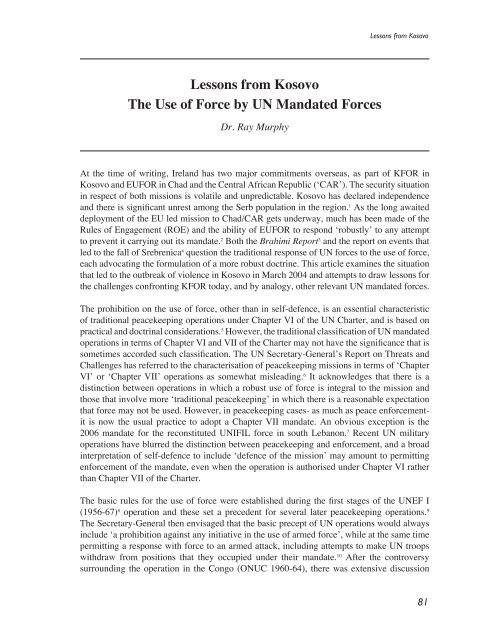Defence Forces Review 2008
Defence Forces Review 2008
Defence Forces Review 2008
You also want an ePaper? Increase the reach of your titles
YUMPU automatically turns print PDFs into web optimized ePapers that Google loves.
Lessons from Kosovo<br />
Lessons from Kosovo<br />
The Use of Force by UN Mandated <strong>Forces</strong><br />
Dr. Ray Murphy<br />
At the time of writing, Ireland has two major commitments overseas, as part of KFOR in<br />
Kosovo and EUFOR in Chad and the Central African Republic (‘CAR’). The security situation<br />
in respect of both missions is volatile and unpredictable. Kosovo has declared independence<br />
and there is significant unrest among the Serb population in the region. 1 As the long awaited<br />
deployment of the EU led mission to Chad/CAR gets underway, much has been made of the<br />
Rules of Engagement (ROE) and the ability of EUFOR to respond ‘robustly’ to any attempt<br />
to prevent it carrying out its mandate. 2 Both the Brahimi Report 3 and the report on events that<br />
led to the fall of Srebrenica 4 question the traditional response of UN forces to the use of force,<br />
each advocating the formulation of a more robust doctrine. This article examines the situation<br />
that led to the outbreak of violence in Kosovo in March 2004 and attempts to draw lessons for<br />
the challenges confronting KFOR today, and by analogy, other relevant UN mandated forces.<br />
The prohibition on the use of force, other than in self-defence, is an essential characteristic<br />
of traditional peacekeeping operations under Chapter VI of the UN Charter, and is based on<br />
practical and doctrinal considerations. 5 However, the traditional classification of UN mandated<br />
operations in terms of Chapter VI and VII of the Charter may not have the significance that is<br />
sometimes accorded such classification. The UN Secretary-General’s Report on Threats and<br />
Challenges has referred to the characterisation of peacekeeping missions in terms of ‘Chapter<br />
VI’ or ‘Chapter VII’ operations as somewhat misleading. 6 It acknowledges that there is a<br />
distinction between operations in which a robust use of force is integral to the mission and<br />
those that involve more ‘traditional peacekeeping’ in which there is a reasonable expectation<br />
that force may not be used. However, in peacekeeping cases- as much as peace enforcementit<br />
is now the usual practice to adopt a Chapter VII mandate. An obvious exception is the<br />
2006 mandate for the reconstituted UNIFIL force in south Lebanon. 7 Recent UN military<br />
operations have blurred the distinction between peacekeeping and enforcement, and a broad<br />
interpretation of self-defence to include ‘defence of the mission’ may amount to permitting<br />
enforcement of the mandate, even when the operation is authorised under Chapter VI rather<br />
than Chapter VII of the Charter.<br />
The basic rules for the use of force were established during the first stages of the UNEF I<br />
(1956-67) 8 operation and these set a precedent for several later peacekeeping operations. 9<br />
The Secretary-General then envisaged that the basic precept of UN operations would always<br />
include ‘a prohibition against any initiative in the use of armed force’, while at the same time<br />
permitting a response with force to an armed attack, including attempts to make UN troops<br />
withdraw from positions that they occupied under their mandate. 10 After the controversy<br />
surrounding the operation in the Congo (ONUC 1960-64), there was extensive discussion<br />
81
















